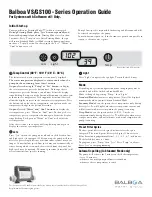
Instructions
© Danfoss | DCS (CC) | 2018.11 | 7
FRCC.PI.052.A2.02
of Eco-design requirements for energy-
related products.
• REGULATION (EU)
2015/1095, implementing Eco-design
Directive 2009/125/EC with regard to
Eco-design requirements for professional
refrigerated storage cabinets, blast cabinets,
condensing units and process Chiller.
• Condensing unit measurements are made
according to standard “EN 13771-2:2007”
– Compressor and condensing units for
refrigeration-performance testing and test
methods- part 2: Condensing units
• The following approvals must be obtained
through authorised institutes like Nemko,
Demko, BEAB, LCJE, etc. Among others EN 60
335-2-24, IEC 335-2-89, IEC 79-15.
8 – Safety
Important service and safety tips
The drier must always be replaced when a
system has been opened.
Blow through the system with dry nitrogen before
soldering.
When a defective system is emptied the
refrigerant must be collected without mixing
with other refrigerants, and the refrigerant
must not leak into the environment.
(See also “Installation“).
The condenser and the complete condensing
unit must be cleaned regularly.
Specified maintenance and cleaning intervals
must be observed.
Working on components that are under
pressure is dangerous.
Beware of hot and extremely cold components.
Beware of moving components (e.g. fan).
Pay attention to sufficient ventilation.
Check the perfect operation of the fan.
The application limits stated by the
manufacturer must be observed.
If pressure controls are specified, they must be
installed professionally.
The operating condition must be monitored in
order to ensure perfect operation.
Check whether the shut-off valves (suction and
discharge side) are completely opened.
Ensure that EN 378 is observed.
If forced ventilation is necessary, this is to be
clearly shown (i.e. by a label).
Do not install in aggressive, moist or dusty
environment.
Do not install or start in rooms containing
flammable gases or in installations operating
with such.
PED (Pressure Equipment Directive 97/23EC)
Condensing units are no „units“ in accordance
with the PED.
The unit/installation into which the condensing
unit is mounted/integrated, must be in
accordance with the PED.
9 – Maximum refrigerant charges
Units with receiver. See fig. 9.
Units without receiver. See fig. 10. The
refrigerants stated on page 3 and 4 must be
used.
It is recommended that only the right quantity
of refrigerants necessary for correct function of
the refrigeration system be added.
For refrigeration systems with capillary tube the
charge must be adapted to suit each system
type.
The operating charge must never exceed the
capacity of condenser and receiver.
Always avoid excess refrigerant charge!
Crankcase heater
If the maximum amounts of refrigerant cannot
be observed in T0, T2, A01, A02, A04 or T0
condensing units respectively, a crankcase
heater or a „pump-down transmission“ must be
used. The crankcase heater must be fitted
directly over the weld.
The crankcase heater will heat the compressor
oil during standstill periods. When the
refrigeration system has been at a stand-still for
longer periods the crankcase heater must be
cut in 2-3 hours before starting. The following
crankcase heaters are recommended
TL and FR: 35 W (code no. 192H2095)
SC: 55W (code no. 192H2096)
10 - Cold start
After installing the unit the compressor must be
allow-ed to assume a temperature higher than
10°C before it is started for the first time. This
will prevent possible start problems caused by
too high oil viscosity.
At lower temperatures some tripping of the
winding protector may be expected until the
viscosity of the oil becomes reduced.
See also „crankcase heater“.
Never start during vacuum!
11 - Winding protector
The compressors have a built-in winding
protector. If the protector cuts out while the
compressor is cold it may take approx. 5
minutes for the protector to reset.
If the winding protector cuts out while the
compressor is hot (compressor housing above
80°C) up to 45 minutes may pass before the
protector resets.
Checking the winding protector
In the event of a compressor failure a check
must be made by resistance measurement
direct on the current lead-in to find out whether
the fault is due to motor damage or simply a
winding protector trip.
Fig. 3. Location of the winding protector in the
electrical circuit.
1A. Main winding
1B. Start winding
1D. Winding protector
If resistance measuring shows that there is a
connection through the motor windings from
points K and S of the current lead-in, but a
broken circuit between points K and F or
between S and F, this indicates that the winding
protector has cut out. Therefore, wait for the
protector to reset.








































